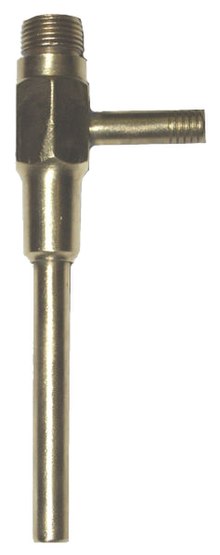Aspirator (pump)

A brass aspirator. The water inlet and outlet are at the top and bottom, respectively; the air inlet is on the side.
|
|
| Other names | Eductor-jet pump, injector/ejector, filter pump, Venturi pump |
|---|---|
| Uses | Vacuum generation, suction |
| Related items |
Injector, vacuum pump |
An aspirator is a type of ejector-jet pump, which produces vacuum by means of the Venturi effect.
In an aspirator, fluid (liquid or gaseous) flows through a tube that first narrows and then expands in cross-sectional area. When the tube narrows, the fluid pressure decreases. In this narrow area the fluid velocity must increase to conserve mass continuity. Where the tube narrows, a vacuum is drawn because of the Venturi effect.
The cheap and simple water aspirator is the most common type of aspirator. It is used in chemistry and biology laboratories and consists of a tee fitting attached to a tap and has a hose barb at one side. The flow of water passes through the straight portion of the tee, which has a restriction at the intersection, where the hose barb is attached. The vacuum hose should be connected to this barb. While previously common for low-strength vacuums needed in chemistry benchwork, they use a lot of water, and depending on what the vacuum is being used for, i.e. solvent removal, they can violate environmental protection laws such as RCRA by mixing these potentially hazardous solvents into the water stream, then flushing them down a drain that often leads directly to the municipal sewer.
If a liquid is used as the working fluid, the strength of the vacuum produced is limited by the vapor pressure of the liquid (for water, 3.2 kPa or 0.46 psi or 32 mbar at 25 °C or 77 °F). If a gas is used, however, this restriction does not exist. The industrial steam ejector (also called the "steam jet ejector", "steam aspirator", or "steam jet aspirator") uses steam as a working fluid.
...
Wikipedia
